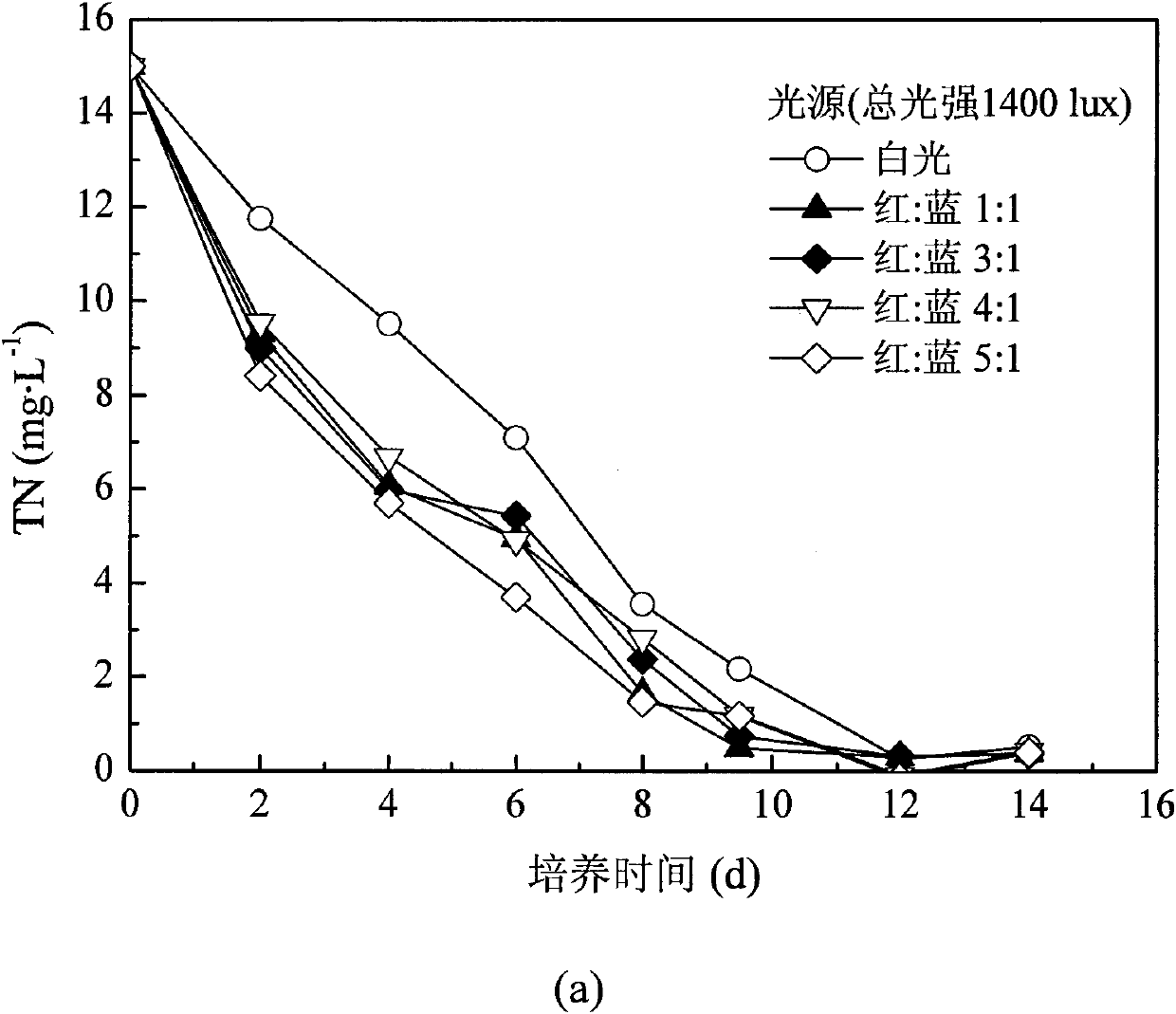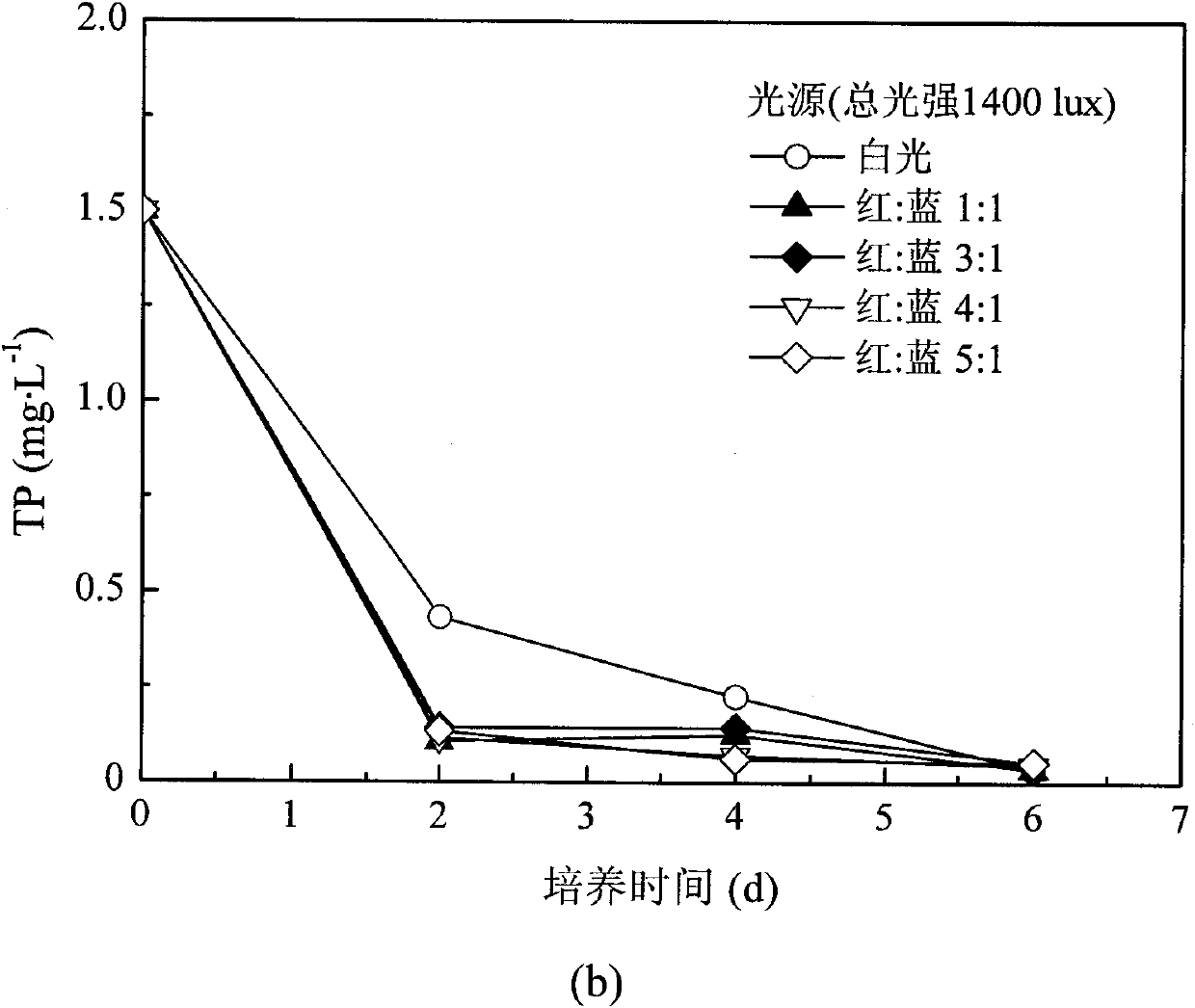Device and method for coupling producing biological oil by utilizing microalgae to deeply treating wastewater
An advanced treatment and bio-oil technology, which is applied in the preparation of liquid hydrocarbon mixtures, energy wastewater treatment, sustainable biological treatment, etc., can solve the problems of difficult sludge treatment, poor removal effect of nitrogen and phosphorus nutrients, and high cost of chemical agents. Achieve the effects of increasing the removal rate of nitrogen and phosphorus, increasing the density of algae cells, and reducing the risk of algal blooms
- Summary
- Abstract
- Description
- Claims
- Application Information
AI Technical Summary
Problems solved by technology
Method used
Image
Examples
Embodiment 1
[0029] To the artificially configured medium (total nitrogen and total phosphorus were 15mg·L -1 and 1.5mg·L -1 , the rest of the components were inoculated with Scenedesmus LX1 in the same diluted 50% BG11 medium), and the initial inoculation density was about 6×10 5 pcs mL -1 , cultured under the conditions of white light and different ratios of LED red and blue light (light-to-dark ratio 14h:10h, light intensity 1400lux).
[0030] Chlorophyll in algae cells mainly absorbs red and blue light in natural light for photosynthesis. Therefore, under the same light intensity, the growth rate of Scenedesmus LX1 can be significantly accelerated by using LED red and blue light as the light source. From the first day after inoculation, the algal cell density of Scenedesmus LX1 was significantly higher than that of white light as the light source until the algal cell growth entered a stable period. With white light as the light source, Scenedesmus LX1 enters the stable period when i...
Embodiment 2
[0032] The culture conditions and light conditions of Scenedesmus LX1 are the same as those in Example 1.
[0033] Since the growth rate of Scenedesmus LX1 is accelerated under the LED red and blue light source (Example 1), the rate of removal of nitrogen and phosphorus by algal cells will also be significantly improved. Under the LED red and blue light source, the total nitrogen content in the medium was significantly lower than that under the white light source from the first day after inoculation until the total nitrogen in the medium was almost completely removed. Using white light as the light source, the removal rate of total nitrogen can reach 97% until the 12th day of cultivation; using LED red and blue light as the light source, the removal rate of total nitrogen can reach 97% after the 9th day of cultivation ( figure 2 (a)).
[0034] Under the red and blue LED light source, Scenedesmus LX1 promoted the removal of total phosphorus similarly to that of total nitrogen...
Embodiment 3
[0036] Using the effluent of the secondary sedimentation tank of a certain urban domestic sewage treatment plant as the medium, Scenedesmus LX1 was cultivated directly (the effluent of the secondary treatment was not filtered or sterilized). The water quality conditions of the effluent of the secondary treatment are shown in Table 1. The culture conditions are : White light intensity 1400lux, light-to-dark ratio 14h:10h, temperature 25°C, relative humidity 75%. The initial inoculation density of Scenedesmus LX1 was 5×10 6 pcs mL -1 .
[0037] Table 1
[0038]
[0039] Water quality index Index value
[0040]
[0041] Total nitrogen (mg·L -1 ) 22.2±0.2
[0042] Ammonia nitrogen (mg·L -1 ) not detected
[0043] Total phosphorus (mg·L -1 ) 0.48±0.02
[0044] COD Cr (mg·L -1 ) 15.6±3.2
[0045] Suspended matter (mg·L -1 ) 6.2±0.8
[0046] pH 7.04
[0047] Turbidity (NTU...
PUM
 Login to View More
Login to View More Abstract
Description
Claims
Application Information
 Login to View More
Login to View More - R&D
- Intellectual Property
- Life Sciences
- Materials
- Tech Scout
- Unparalleled Data Quality
- Higher Quality Content
- 60% Fewer Hallucinations
Browse by: Latest US Patents, China's latest patents, Technical Efficacy Thesaurus, Application Domain, Technology Topic, Popular Technical Reports.
© 2025 PatSnap. All rights reserved.Legal|Privacy policy|Modern Slavery Act Transparency Statement|Sitemap|About US| Contact US: help@patsnap.com



